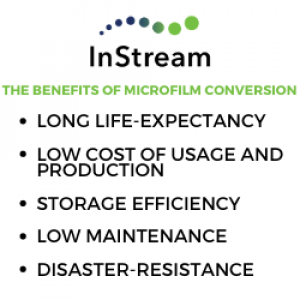An Introduction to Microfilm Conversion
Microfilm is almost as old as photography itself. Since its beginnings in the early 1800s, microfilm has gone on to become one of the most used systems for archiving. It consists of a length of film that contains microphotographs that are projected and magnified through light on a screen. When most people hear the word “microfilm”, they think of a large machine in a library basement to view old newspaper clippings. Now with digital technology, it has even more uses, benefits, and potential. Microfilm conversion brings these documents to the modern-day digital world.
Preserving historical and important data from old newspapers, photos, and other artifacts are crucial. However, using microfilm has become less popular with many resources now being accessible digitally. Microform conversion of microfilm, microfiche, and microcards or micro-opaques, into digital documents provides your users with digital access to the same data through a simplified process.
The Paper Cut: This One Won't Hurt Document & Microfilm Conversion for the Remote Workforce
Step into the Digital World
Accessing microfilm is challenging and often time-consuming because the rolls contain large amounts of information. It can also be hard to access and share between employees and departments. Digital formats are much easier to use and more manageable and with OCR, searching for information is more efficient. Microfilm deteriorates over time, especially if it is not in the proper storage environment, resulting in a decline of image quality, where it is no longer legible. Conversion will also cut down on the space that was reserved for microfilm and microfilm reading rooms.
Digital technology has taken microfilm to new heights. It can now be digitally scanned onto a computer. With digital technology, you can both convert microfilm to digital images or convert digital images to microfilm. Converting microfilm to digital images allows for images to been viewed over the internet or on a disc. Microfilm can be turned into PDFs and other formats, such as CDs or DVD’s for portability.
The Benefits of Microfilm Conversion

Saving time is a benefit to anyone in this day in age. However, looking for certain information on microfilm is the opposite of that, taking up time and space. No one has the time to search through rolls and rolls of data. Microfilm conversion to electronic documents will create less stress on you and save you time. Once transitioned, everyone can access the information from their own home rather than going to the library and courthouses for public records. Libraries and other public organizations will be able to offer patrons more access to archives that before, would be very limited. Digitized microfilm information allows anyone anywhere to access the same information.
To learn more about InStream and our document preservation services...
Digitizing microfilm is perfect for publications, magazines, and newspapers looking to offer online subscriptions. It is also ideal for companies looking to digitize their old archives. Converting microfilm from digital images allows for the reproduction of identical images that are neither edited nor changed.
Managing Microfilm on Document Management Software
Combine the power of digital formatting with document management software. Finding documents will become much easier and faster when using electronic document management for your microfilm. You can stop worrying about the amount of time it will take you to sift your way through many loads of documents. Moving away from microfilm also allows you to share these documents with other people. Switching over to electronic documents will also save a large amount of storage space, providing companies more space to store information. This creates an all-around more efficient process.
Document management solutions will automate your manufacturing processes from start to finish. Execute and track work through its lifespan to ensure your customers receive the best possible service.
Since so much of the information stored is relatively old, it requires a high expense to keep the older technology intact. The parts used to run older technology are much more expensive. Using electronic files will save money for any company that is still using microfilm. Switching over to digital will also keep the quality of the film. It is only natural that the film will become tougher to view as time goes on. As the film becomes older, they start to ware, and the quality of the film decreases. These documents will end up lasting much longer and will be able to be used for a longer period.
Document Management Improves Access and Organization
Not only will these documents be easier to find, but also, they will be better protected. When going digital, you can decide who has access to these files. When using microfilm, anyone can see these files. Some of this information is very worthy and made up of historical data. You do not want to take a chance of losing such valuable files. Electronic documents allow you to back up the information in case any situation was to occur. You can easily back this information up when using an electronic device.
Let InStream Transition your Microfilm
Microfilm is a unique format. While digital technology has rendered many older technological formats obsolete, Microfilm and Digital Technology can be used in tandem. Using it along with digital technology can offer outstanding archival solutions to any business or organization.
InStream can scan any standard microfilm format and upload those documents into an electronic document management system. InStream is a Certified Kodak Image Guard Lab, offering a complete microfilm processing and duplication program monitored by Eastman Kodak for quality.


